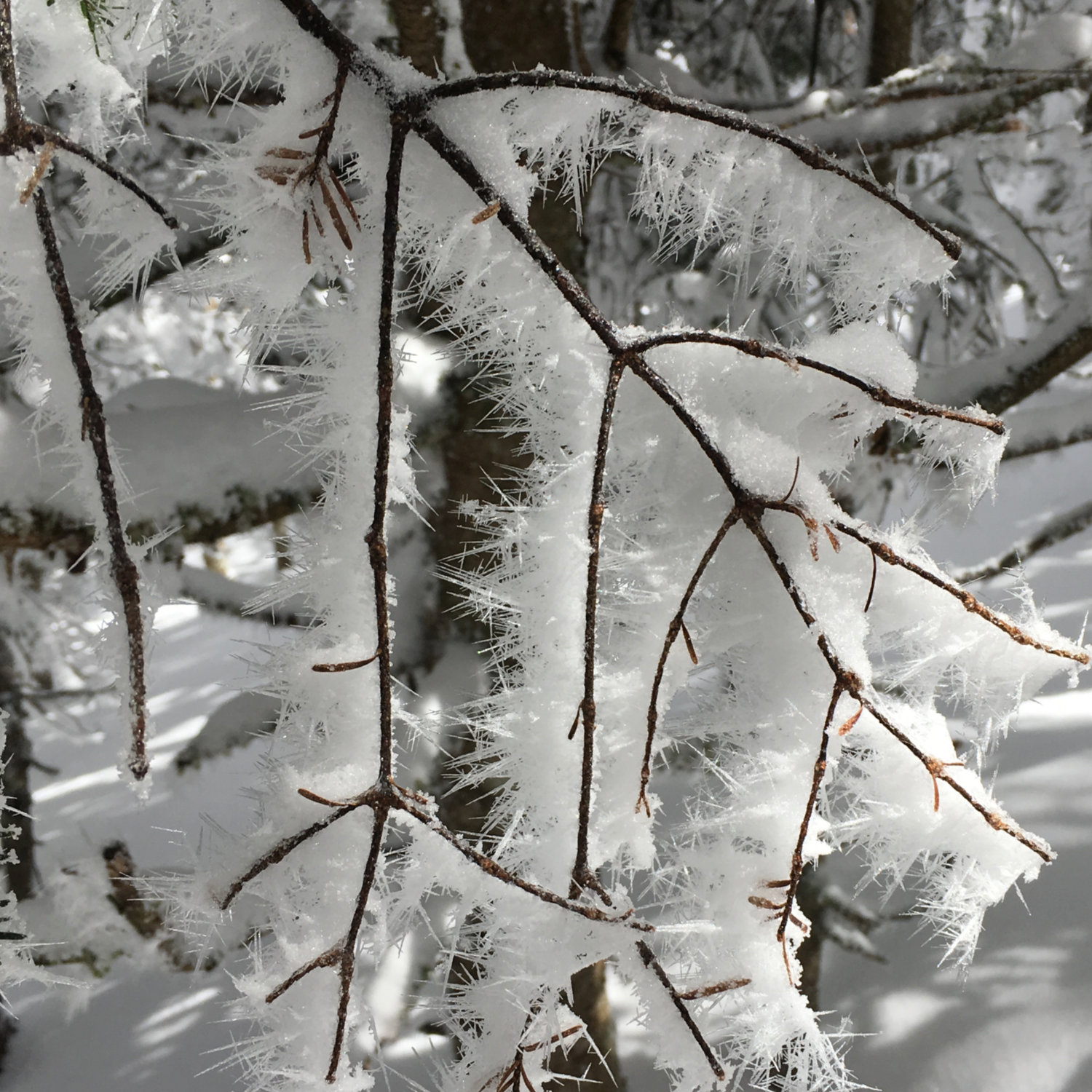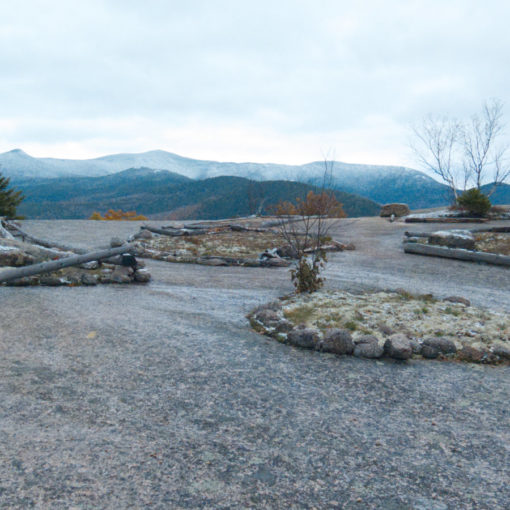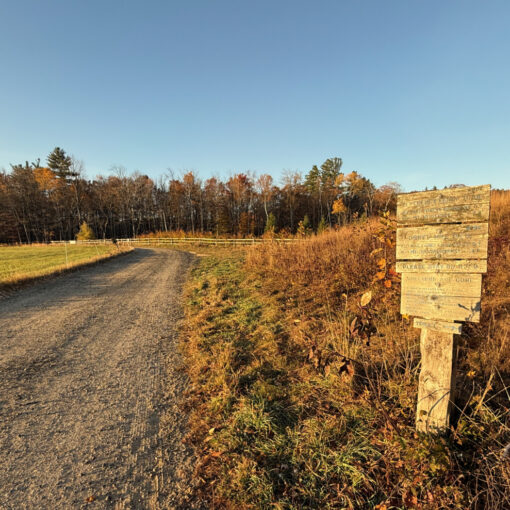Today, I’m continuing on the discussion that I started in my post “avoid getting cold.” I’ll lay out strategies relating to cold weather dress, touching on fibers, layering strategies, ventilation, and feet, hands, and head. I know for a lot of my readers, this will be old hat, but I still see a lot of newbies out on the trail who haven’t got this memo and think it’s fine to go out hiking in blue jeans and cotton hoodies. If you’re indeed one of these newbies, welcome, pull up a seat and make yourself comfortable, and please, arm yourself with knowledge, so you can be safer out there, enjoying the mountains in more comfort. Everybody ready? Good! Now let’s begin…
So first off, a reminder: to the absolute degree possible, do everything you can to stay dry out there. That’s going to be from both extrinsic and intrinsic sources — both precipitation and sweat. Remember that water transfers heat about 25 times more effectively than air: a wet body will chill faster than a dry one, and it only takes a little bit of a breeze to make a big change in temperature due to wind chill. Don’t forget your high school science class: it takes one calorie to raise the temperature of a gram of water by one degree celsius. You burn calories just staying warm. You burn even more calories if you get chilled and have to get warm again. So stay on top of being dry. It goes hand-in-glove with being warm.
Now, let’s start with fibers…
Simply put, cotton is to be avoided at all costs. It’s a great fiber in its proper realm. It’s strong, lightweight, comfortable, and it retains a significant amount of its weight in water. We love this in the bath, in the form of thick, soft towels and bathrobes that make us nice and dry. The scientific terms at work here are hydrophilic, and hydrophobic. Cotton is hydrophilic: it retains water. Synthetics are hydrophobic: they don’t retain water.
A quick sidebar: Microfiber towels (a common brand is MSR’s PackTowl, and some of you will remember the “Sham-Wow”) are the odd duck, being both synthetic and hydrophilic. The short of it is the fiber itself has microscopic splits in it, that allow it to hang onto moisture by “van der Waals force.” It’s the same thing that allows insects and geckos to climb walls. So while they’re synthetic, it’s the massive, microscopic surface area that allows a microfiber towel to “hang on” to moisture droplets.
To put numbers to it, I did an experiment.
I took two tees, one made of 100% cotton, the other 100% polyester. Both were fairly identical in terms of size (men’s medium) and weight. Starting out, the cotton shirt was 150 grams, the poly shirt was 145. I then dunked both in water, swished them around to ensure they were thoroughly soaked, and hung them up for fifteen minutes so they could shed excess water.
The wet poly shirt weighed 334 grams, while the cotton shirt was 434 grams — 100 grams, and about 30% heavier. Another way to think about this is that 100 grams is the weight of 20 US nickels — the cotton shirt was carrying around a dollar’s worth of loose change!
Then the next test: I hung both shirts to dry, with a fan pointed at them from about four feet below. About a foot away from the shirts, the breeze barely registered 1 MPH on my meter, and it wouldn’t even spin the vanes when I held it nearer to the shirts than that. So we’re talking a very light breeze, just enough to make then move a little.
It took 90 minutes for the polyester shirt to dry, and a fair bit before that, the shirt felt almost dry enough to put on comfortably. Even at two hours, the sleeves of the cotton shirt still felt uncomfortably clammy — there wasn’t a moment when I felt it and thought “gee, I could put this on right now.” Someone with better knowledge of the science behind evaporative cooling can make more out of this, but it illustrates just how much cotton retains water. (For those who want to see the raw data, along with a graph, I’ve included a PDF at the bottom of this post.) Now imagine that cotton shirt is on your bod, and the wind has kicked up a notch. And you’re above treeline. Oh goody.
The lesson from this? Nose to toes, you should be clad in synthetics when hiking, and that includes everything from your outermost garments to your innermost. On the bright sunny days of summer, when we’re enjoying conditions that are like none other, yes, the cotton tee probably isn’t going to be the achilles heel of your hike. But certainly in winter, it can ruin your day in very short order.
I mentioned polyester specifically, and it’s a good fiber to wear. Yes, there’s stuff like polypropylene and others, but once you get into synthetics in general, you’re doing miles better than cotton, and further refinements are going to yield increasingly diminishing returns. I wouldn’t obsess over it beyond thinking about fit and finish — if Brand X has a garment that feels heavenly on your body, run with it.
So now on to layering… the basics…
The basic idea is to mimic an onion. You wear multiple layers of clothing, so as your level of activity rises, you can peel off layers so you don’t overheat (and fill your clothes with sweat). Then when you slow down again, or maybe even stop to have lunch, camp, or whatever, layers go back on again to retain your heat. (And yes, sometimes those layers might initially be cold from sitting in your pack — you may need to run in place or do some quick jumping jacks to fine tune things. Or, thinking ahead, consider proactively adding a layer a short bit before you expect to be stopping.)
There’s a couple camps on layering. But both start with the same basic first layers. You’ve got your undies, and anyone who’s cheated on this knows that if nothing else, cotton undies catch up to you when you have to sit down for the long car ride home. ‘Nuff said about that. In cold weather, you need a reasonably snug layer that’s going to cover you from ankles to wrists to your neck. Whether it’s purpose built long-johns, or you’ve got a pair of running tights with a compression shirt, or whatever you want. But have a layer that can sit directly on your skin and wick away sweat.
Insulating by fluff…
The fluff layer, providing your insulation, is where the two camps diverge. Some prefer to layer up with some polar fleece of some sort and thickness. Others advocate wearing several thinner layers, so you can fine tune your comfort. Either way, they should be tight enough to trap warm air next to your body, yet loose enough that you can actually move around. Experimentation will help you dial in what’s best for you. (I do, of course, encourage you to do this experimentation safely, where you have options to get back into warmth quickly if needed. Don’t leave this until the day you decide to hike Mt Washington in questionable conditions.)
On weird weather days, I like having a base layer with a zipper, ideally one that goes a fair bit down the front — with a deep 3/4 zip base layer under a zip-up fleece, I can cool down easily on steep uphill stretches when I’m really bustin’ it out and working hard. Then when the grade eases, I can zip back up without slowing down.
Then the shell…
Over this, you need something that can hold back the worst of the elements. In the ideal, this is both waterproof and breathable, where you’ll be bone-dry in a torrential downpour of freezing rain. Gore-Tex and its clones are a good option. But here’s where science tosses a spanner in the works.
Remaining dry requires that the weather inside your clothes is capable of pushing moisture to the outside of your clothes. It’s high school chemistry stuff (specifically “vapor pressure”) that I’ll let you research on your own. But suffice it to say that things naturally migrate from a higher concentration to a lower one. If it’s pouring with rain, it’s going to be hard to get your perspiration to high tail it out of your parka. Waterproof/breathable fabrics work best at migrating your sweat on dry days. People in the Pacific Northwest lament this simple truth.
So don’t just get a super-spiffy waterproof/breathable parka and think that’s the end of it. You still need to manage your insulation layers and ventilate if needed. It can rain and snow inside of your shell if you’re not attentive. Pit zips, a hat instead of a hood, maybe unzip inner layers and crack the top of your outer layer… you get the idea. You still need to protect yourself from the wind, because you don’t want to get areas of frostbite, so approach ventilation with due care. Usually it’s less of an issue in the trees, but it’s certainly something that needs to be at the front of your mind above treeline.
Now it’s easy to think of shells as being your outer jacket. Don’t forget your legs. I really like hard shell pants with full length (hips to ankles) zips. I started out wearing fleece pants under them, but then more recently, I’ve been finding I’m just as comfortable wearing a pair of hiking pants underneath on most days. Your mileage may vary on this. But the zips on the shells can do a lot to keep me cool. I can unzip down to above my knees, and now my biggest muscles (read: biggest heat generators) have a direct line to the outside air. On steep uphills, it makes a huge difference. When I hiked Washington recently, that was me from about Gem Pool up until I got to Lakes of the Clouds. Don’t get in the rut of thinking ventilation is only for your upper body.
Feet, hands, and head…
I’ll point to my recent post on mittens, and you can see there that even with mittens, I layer. A thin pair of glove liners inside your mitts will up the insulating capability by a few degrees, and if you have to take your mitts off to do something, your skin isn’t in direct contact with the cold. Good stuff.
Feet can get a little weird. Some people develop blisters no matter what they try. Some people are allergic to wool. I will say that sheep have been wearing wool for millennia and for good reason. It’s nice and cushiony, which your feet need to keep you moving. It insulates even when wet. And it’s not bad at transporting moisture. I couple mine with a thin liner sock, typically made of Cool Max. In more than twenty years of having this as my sock ensemble, blisters haven’t ever been a thing. (And this is what I wear on my feet year ’round.) But again, your mileage may vary. Experiment, and do what’s right by your feet.
It’s also worth noting that your boots are a part of the insulating game. The pair of lightweight trail runners that’s awesome in summer is probably not going to do you in the snow and ice of winter. Winter hiking calls for winter gear. If the marketing materials for your hiking shoes talk about how wonderfully they breathe and keep your feet cool, ask yourself if you need to get a new pair of boots. Again, this is going to be as personalized a choice as your sock ensemble. If you’re new to the game, consider going to a local outfitter and talking to one of the pros rather than buying online.
Hats are, in my mind, one of the best ways to regulate your temperature. You’ll see me on the mountains wearing hats of varying styles, as well as fleece headbands. The old saw is that you lose so many percent of your heat through your head. But guess what? If you’re not wearing a hat, it’s going to be a given that you’re losing heat through the most obvious body part! So right off the bat, if you’re feeling cold, try hanging a hat on your noggin and go from there. But also, if you’re starting to warm up a lot, take off your hat! If the weather is weird, hats and headbands are of negligible weight, so bring a selection of both.
Anyone can see that I log weather conditions, and it’s to inform my wardrobe choices. If it’s an otherwise warm winter day, with just a biting wind, I’ll likely head out with just a windproof headband to keep my ears from freezing. Log your hikes similarly, and you’ll have a much better idea of what keeps your temperature in the Goldilocks zone.
Closing this out… Technologies that I like…
Obviously, I like synthetics. I mentioned that polyester is pretty good stuff, and just about any of the major manufacturers who make outdoor gear is using some kind of hydrophobic fiber. Tighter knits and weaves are going to do a better job of blocking the wind than more open knits and weaves. Think about balancing those out to achieve proper comfort. Different days will want different garments. Fleece, both regular and wind stopper, is a fine choice in my book. I’ve done well with Primaloft insulation, and I’ve got a “lightweight” down parka that tends to be a raging furnace when I need it. Also, there are days when I leave the house with all long sleeves, and there are days when shorter options are better. Don’t get dogmatic, thinking winter weather always requires that your body is 100% hidden underneath piles of clothes. And lest we forget, wool socks have always meant supreme comfort to my feet, especially with a pair of Cool Max liners.
So there it is. If any of this is new information to you, I highly encourage safe experimentation — if you test out new gloves shoveling snow after a blizzard, where the front door to the house is just steps away, that’s not a bad idea. Consider a nice jaunt down a local rail trail, or walk around your local pond on a windier day to get a little exposure. As you gain comfort and fluency with your gear, extend your outings to things that are more challenging until you feel you have things sussed out. Again, the summit of Washington in lousy weather is no place to find out your winter weather ensemble is lacking in a few key areas.
Leave comments, ask questions. I know this was a longer post than normal, and we covered a lot of ground. I encourage everyone to research this topic further, because staying warm is literally a life and death concern when you’re out in the mountains. The internet and your local library are both great starting points. If you’re that kind of geek, things like vapor pressure, heat transfer, and that sort of thing can keep you busy for hours. It’s pretty fascinating stuff.
Also, I have a new contact form for anyone who didn’t notice, and that’s a direct line to me if you need.
As always, be safe out there.
If you enjoy reading these posts, please subscribe — stay in the loop! Your email will only be used to alert you of new posts — typically 1-2 times per week. I will not use or share your email for any other purpose without your express permission.




